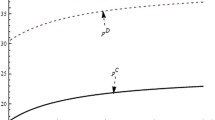Abstract
Under the environment of technological spillover, carbon abatement investment has become one of key factors on cutting reducing carbon emission, which includes production costs in the components and products. Based on demand with price elastic, we study a dyadic supply chain consisting of a retailer and a manufacturer to explore a two-echelon Stackelberg model for obtaining the optimal decisions of decentralized and centralized supply chain within the dominated manufacturer. With the coordination contract through revenue-cost sharing, setting the decentralized profits of players as the disagreement points, the manufacturer and the retailer can achieve the goal of centralized scenario, which can promote the members to increase the carbon abatement investment and decrease the retail pricing. Finally, by theoretical comparison and numerical analysis, the results show that technological spillovers amplify the impact of “free-ride” behavior, which the supplier always has incentives to reduce carbon emission, but the cooperation of players will achieve as well as improves the profits only when technological spillovers are large.
Similar content being viewed by others
References
Sarkis J, Zhu Q, Lai K (2011) An organizational theoretic review of green supply chain management literature. Int J Prod Econ 130:1–16
Yu YG, Han XY, Hu GP (2016) Optimal production for manufacturers considering consumer environmental awareness and green subsidies. Int J Prod Econ 182:397–408
Kwon CW, Chun BG (2015) The effect of strategic technology adoptions by local firms on technology spillover. Economic Modeling 51:13–20
Qiu JP, Wan C (2016) Technology spillovers and corporate cash holdings. J Financ Econ 115:558–573
Isaksson HD, Simeth M, Seifert RW (2016) Knowledge spillovers in the supply chain: evidence from the high tech sectors. Res Policy 45:699–706
Dietmar H (1996) Strategic spillovers and incentives for research and development. Manag Sci 42:907–925
Olov HD, Simeth M, Seifert R (2016) Knowledge spillovers in the supply chain: evidence from the high tech sectors. Res Policy 45:699–706
Bloom N, Schankerman M, Reenen J (2013) Identifying technology spillovers and product market rivalry. Econometrica 81:1347–1393
Henriques I (1990) Cooperative and non-cooperative R&D in duopoly with spillovers comment. Am Econ Rev 80(3):638–640
Cassiman B, Veugelers R (2002) R&D cooperation and spillovers: some empirical evidence from Belgium. Am Econ Rev 92:1169–1184
Orlando MJ (2004) Measuring spillovers from industrial R&D: on the importance of geographic and technological proximity. RAND J Econ 35:777–786
Mussa M, Rosen S (1978) Monopoly and product quality. Journal of Economics Theory 18:301–317
Wang J, Blomstrom M (1992) Foreign investment and technology transfer: a simple model. European Economics Review 36:137–155
Steurs G (1995) Inter-Industry R&D spillover: what difference do they make? Int J Ind Organ 13:249–276
Poyago J (1995) Equilibrium and optimal size of research joint ventures in an oligopoly with spillovers. J Ind Econ 43:209–225
Benjaafar S, Li Y, Daskin M (2013) Carbon footprint and the management of supply chains: insights from simple models. IEEE Trans Autom Sci Eng 10:99–116
Boyaci T, Ray S (2003) Product differentiation and capacity cost interaction in time and price sensitive markets. Manufacturing Service and Operation Management 5:18–36
Ashkan H (2017) Competition, cooperation and coopetition of green supply chains under regulations on energy saving levels. Transportation Research Part E: Logistics and Transportation Review 97:228–250
Cao J, Zhang XM (2013) Coordination strategy of green supply chain under the free market mechanism. Energy Procedia 36:1130–1137
Abdallah T, Farhat A, Diabat A et al (2012) Green supply chains with carbon trading and environmental sourcing: formulation and life cycle assessment. Applied Mathematical Modeling 36:4271–4285
Du SF, Zhu LL, Liang L, Ma F (2013) Emission-dependent supply chain and environmental policy-making in the ‘cap-and-trade’ system. Energy Policy 57:61–67
Du SF, Ma F, Fu Z et al (2015) Game-theoretic analysis for an emission-dependent supply chain in a 'cap-and-trade' system. Ann Oper Res 228:135–149
Liu HH, Ming L, Deng HH et al (2016) A dual channel, quality-based price competition model for the WEEE recycling market with government subsidy. Omega 59:290–302
Shibata T (2014) Market structure and R&D investment spillovers. Economic modeling 43:321–329
Sigue SP, Chintagunta P (2008) Advertising strategies in a franchise system. Eur J Oper Res 198:655–665
Zhang JX, Liu GW, Zhang Q et al (2015) Coordinating a supply chain for deteriorating items with a revenue sharing and cooperative contract. Omega 56:37–49
Ghost D, Shah J (2015) Supply chain analysis under green sensitive consumer demand and cost sharing contract. Int J Prod Econ 164:319–329
Author information
Authors and Affiliations
Corresponding author
Rights and permissions
About this article
Cite this article
Xu, L., Wang, C. Contracting pricing and emission reduction for supply chain considering vertical technological spillovers. Int J Adv Manuf Technol 93, 481–492 (2017). https://doi.org/10.1007/s00170-017-0116-5
Received:
Accepted:
Published:
Issue Date:
DOI: https://doi.org/10.1007/s00170-017-0116-5




